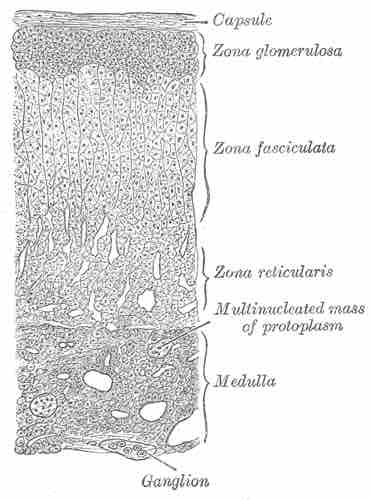The cortex is regulated by neuroendocrine hormones secreted by the pituitary gland which are under the control of the hypothalamus, as well as by the renin-angiotensin system. The adrenal cortex comprises three zones, or layers: Zona glomerulosa (outer), Zona fasciculata and Zona reticularis. The outermost layer, the zona glomerulosa is the main site for production of mineralocorticoids, mainly aldosterone, which is largely responsible for the long-term regulation of blood pressure. Aldosterone exerts its effects on the distal convoluted tubule and collecting duct of the kidney where it causes increased reabsorption of sodium and increased excretion of both potassium (by principal cells) and hydrogen ions (by intercalated cells of the collecting duct). The major stimulus to produce aldosterone is angiotensin II while ACTH from the pituitary only produces a transient effect. Angiotensin is stimulated by the juxtaglomerular cells when renal blood pressure drops below 90 mmHg. Zona fasciculata is the layer, situated between the glomerulosa and reticularis, this layer is responsible for producing glucocorticoids, such as 11-deoxycorticosterone, corticosterone, and cortisol in humans. Cortisol enhances the activity of other hormones including glucagon and catecholamines. Zona reticularis, is the inner most cortical layer; the zona reticularis produces androgens, mainly dehydroepiandrosterone (DHEA) DHEA sulfate (DHEA-S), and androstenedione (the precursor to testosterone) in humans.
Mineralocorticoids
They are produced in the zona glomerulosa. The primary mineralocorticoid is aldosterone. Its secretion is regulated by the oligopeptide angiotensin II (angiotensin II is regulated by angiotensin I, which in turn is regulated by renin). Aldosterone is secreted in response to high extracellular potassium levels, low extracellular sodium levels, and low fluid levels and blood volume. Aldosterone affects metabolism in different ways:
- It increases urinary excretion of potassium ions
- It increases interstitial levels of sodium ions
- It increases water retention and blood volume.
Glucocorticoids
They are produced in the zona fasciculata. The primary glucocorticoid released by the adrenal gland in the human is cortisol and corticosterone in many other animals. Its secretion is regulated by the hormone ACTH from the anterior pituitary gland. Upon binding to its target, cortisol enhances metabolism in several ways:
- It stimulates the release of amino acids from the body
- It stimulates lipolysis, the breakdown of fat
- It stimulates gluconeogenesis, the production of glucose from newly-released amino acids and lipids
- It increases blood glucose levels in response to stress, by inhibiting glucose uptake into muscle and fat cells
- It strengthens cardiac muscle contractions
- It increases water retention
- It has anti-inflammatory and anti-allergic effects.
Androgens
They are produced in the zona reticularis. The most important androgens include:
- Testosterone : a hormone with a wide variety of effects, ranging from enhancing muscle mass and stimulation of cell growth to the development of the secondary sex characteristics.
- Dihydrotestosterone (DHT): a metabolite of testosterone, and a more potent androgen than testosterone in that it binds more strongly to androgen receptors.
- Androstenedione (Andro): an androgenic steroid produced by the testes, adrenal cortex, and ovaries. While androstenediones are converted metabolically to testosterone and other androgens, they are also the parent structure of estrone.
- Dehydroepiandrosterone (DHEA): It is the primary precursor of natural estrogens. DHEA is also called dehydroisoandrosterone or dehydroandrosterone. The reticularis also produces DHEA-sulfate due to the actions of a sulfotransferase, SULT2A1 .

Adrenal Cortex
The layers of the adrenal cortex are shown in this figure.